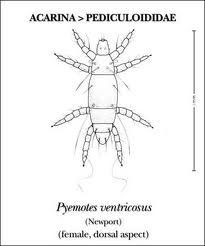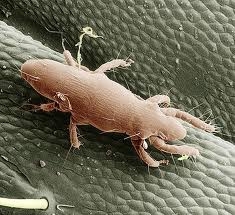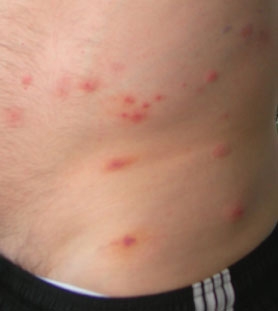- Author: Larry Godfrey
- Author: Rachael Freeman Long
The straw itch mite (Pyemotes ventricosus) is a predator living in oat hay fields. It is an extremely small mite (1/125 inch long), elongate, and whitish to translucent in color. It feeds on small insects and mites in the field and also continues to feed on these organisms in hay bales. This sounds very positive and beneficial, but this mite can also be a severe pest. During the “heat of the summer” every year, there are reports of bites and dermatitis associated with handling given lots of oat hay. The straw itch mite will move out of hay bales and readily bite humans and other animals. At the time of the bite, a prickling sensation may be felt with the “full force” of the bite being felt several hours later. Other commodities such as grains, beans, cottonseed, etc. have also been reported to be sources of this mite. Alfalfa has not been reported to be a host, but alfalfa bales can be infested if stored next to infested stacks of other hay, such as oat hay.
This pest occurs every year to some extent with reports suggesting it is worst during years following wet winters/springs. Based on reports over the years, hay originating from the coastal range/foothills seems to be most affected but the full distribution of this mite has not been studied. Populations decline slowly in stored hay and generally reach a tolerable level after winter storage. Several treatments for straw itch mite were studied in the 1980’s such as tarping hay stacks, treating the hay with an insecticide, etc. but nothing significantly reduced the mite levels. If infested hay must be fed, handling during cool periods (below ~65°F) can be helpful as the mites are less active. However, this may not offer any protection of horses, cattle, and other mammals that may be bitten. For personal protection, mosquito repellents help to keep the mites from biting and even baby oil can provide some protection.
Human response to straw itch mites varies considerably. Some people are not bothered by the mites, while others respond with large, red, itchy welts. Some people exhibit flu-like symptoms from the bites with low-grade fevers.
Line drawing of straw itch mite (www.eol.org).
Electron microscope image of straw itch mite (http://www.fibrotar.it)
Straw itch mite bites on stomach (http://freeforumzone.leonardo.it/lofi/Pyemotes-ventricosus-) .







thanks
What remedies van I use to cure / get rid of the rash? I have been bitten repeatedly and the bites just doesn't go away.
Unfortunately I am not a medical doctor and could not comment on remedies for the bites - "out of my league". In terms of preventing the bites, baby oil sometimes helps. The mites are so small their movement is impeded by the oil. I also hear that the mosquito repellents (containing DEET) can help to repel the mites and thus the bites but I don't have any proof of that.
Good luck, Larry
Sarah
I have heard of mosquito repellents helping with these itch mites in some cases. Baby oil on the skin can also help to keep them from biting. Once bitten, the usual range of skin irritation remedies can help - the hydrocortisone creams, etc.
It has become so demoralizing to work one particular yard in the hills around Simi Valley. Is there any way to find out if there is a particular outbreak of bites from these mites in my area? Every doctor I talk to have no idea what these things are and just look at me like I'm crazy. The only thing that worked in bringing down the bites relatively quickly was prescribed steroids. Not fun.
Thanks for the research.
I've ever dealt with. I went to the doctor she gave me a shot of kenolog
And told me to use caladryl but it's not helping at all. I scratch so hard I bring blood.
What do you suggest I do now?
Sorry - we're not medical doctors. Keep checking with your doctors.
Dan
Ssam,
The mites are really impossible to see without a microscope. Even with a microscope, they are basically invisible. At best you might see “moving dust particles”. You can try to stick tape on the infested area and may be able to see them.
I’m not really qualified to discuss treatment of the animal. A good vet clinic should be able to help. There should be skin treatments that can help with straw itch mites or other topical mites. Fleas are always an issue but seems a bit early for them in central CA right now.
For treating the sofa, there are over-the-counter items that can be used such as for fleas. I doubt they will help much. Depending on the size and structure, you could remove the cloth covers, bag them, and either freeze them or heat/microwave them to kill the mites. That will work.
The mites will not establish on animals. But biting will be a problem as they move off the hay to the animal, bite and perhaps back to the hay. The problem will dwindle over a period of weeks but very pestiferous for a while.
Removing the top growth (leaves, etc.) will help with the itch mite problem. They will continue to live on the stubble but without leaf tissue to infest they will suffer and levels will decline. Survival on mulch, shavings, etc. is not possible. They could perhaps infest these areas for a few days due to the moisture and cooler conditions but they are not going to survive. Good luck.
Thanks
The itch mites generally do not survive very long in the hay bales. Since the hay is dry and continues to get drier, the mites cannot survive these conditions so over time the levels go down. Usually after several weeks, they are at tolerable levels in the hay. It might help to spread the bales out as much as possible to facilitate the drying.
The mites build-up more on the plants in the field during wet winters/springs, so I expected this to be a bad year for them. There is nothing you can do to treat the hay to get rid of them.
For you, I believe that applying baby oil before handling the infested bales can help reduce the mite bites. It is sticky enough to slow down their movements. After being bitten, the Hydrocortisone Anti-Itch Creams usually help to heal the bites unless you are super sensitive, i.e. allergic, to them. If so, this might require stronger creams and it would be best to see a physician.
Sit on these hay bales at the ceremony. Only later the evening I started itching. The next morning
I am completely covered in these red marks. - all over my back. My question
Is, how long does the marks last. I have been taking tablets and cream. On day 2 now, still itches like hell.
And how long will the marks be on my body
They can be pretty uncomfortable. In terms of time, I believe everyone differs in their response. Just like mosquito bites where some people hardly feel them and for others it is an ordeal. I hear a week is a common time for the discomfort to go away from the straw itch mites. I had an employee in my lab that was bitten badly and in two days they were gone. The “danger” is getting them infected. The hydrocortisone topical creams can help with the itch. Make sure that car seats, jackets, etc. are not infested. The mites will not inhabit and live on these long-term but they could survive on these items for a few days and reinfest you and/or bite you. Good luck.
This really works, I use the spray every day when feeding my cattle, NO Mites !!
Dan
Thanks for creating this place to discover learn and deal with these mites and thanks for any advice given
George
We have expensive robots and other equipment
BUT there are hand held solutions out there with a quick internet search.
Good luck!
I have also found the Poultry-zyme and Kleen Green enzyme products to be helpful for spot treating an area. I found this before the bug spray site, so I just offer it as another helpful location. I wish everyone the best success in putting this challenge behind them for good!
I mist say it is a close to impossible thing to pinpoint bites that are not mosquitoes, fleas, midgies /sandfly/no seeums, bedbugs or the other common gamete of insects most of the general population are familiar with. It seems that the world stops at the most common insects when it comes to bites and there's very little information about anything else out there, and many lack good observation skills unfortunately.
So I narrowed it down to bird nest might after months and months of research and even trying to find an entomologist (not knowing that this was the official name people that specialise in insects). So after reading up on Bird nest mites, and suspecting the many birds nesting outside my window in a row of cypress trees, I vacuumed and cleaned my house from ceiling to floor with a solution of neem, tea tree oil and lavender. My pets were treated, any clothes lying around washed and bedding and furniture sprayed. This seemed to stop all bites going forward and I had had success.
Going forward four years, i'm covered again in bites.... however we don't have the birds nesting at the moment despite having a row cypress trees at our new house. My clever partner who also has good observation skills, noticed that the bites had appeared after I had been using the bag of hay. As I am the only one that feeds the bunny hay because my partner is allergic, I am the only one with bites. I had initially thought it was a rogue sugar ant that had made its way into bedding at night time, however this makes far more sense!
They are use comes from Germany, is quite leafy and moist which sounds like the perfect host for hay mites. Without Mr Godfrey I would not have know about this.
I thank you all for your tips, and Mr Larry Godfrey starting this post. My hay is in the freezer and the house is about to be blitzed!
Itch mites, I am certain. Although I am no longer housesitting for them I’m still getting bit. It sounds like camphor oil or Teatree and coconut oil will kill them on my body. Would this be correct? Even though I have been away from the source for a week, I am still getting bitten. It seems as though everything calms down and went away and then suddenly I can feel myself getting bit and sure enough have rows of tiny but voraciously itchy bites on my face and my body.
I also found that cedarwood oil that can be purchased on line, can be sprayed on household items which causes itch mites to immediately close their breathing valves, making it uncomfortable for them to stick around.
Invisible critters with a huge bite!!! I’ve been absolutely miserable, and do not want scarring on my face from these bites. Any other solutions greatly appreciated!
Thanks, everyone.
I thought i was bitten by a rouge flea from a stray cat ive been feeding. Bites started in my arms, then waist, then neck (never legs). I have house cats and a dog and all were treated for fleas (including the stray cat). I have sprayed house all over with specialist stuff, yet i am still being bit. I get bit by everything, you name it, it loves me, especially horse flies that normally end up infected. So here i am, 4 days after fumigation of the house and pets with NEVER seeing one flea, when i came across this forum.
Heres the funny part. I have horses and due to the extreme heat we have had this past week (june), ive been given my horses hay nets off a large bale. So now im thinking hay mites?? But, the weird thing is, ive been taking hay off this bale for over a month+ and bites only been happening this past week? I always wear gloves and a waterproof type coat (to stop getting bitten by the horse flies), so if it is the hay mites, how are they getting on my skin thru clothing? And how come its been over a month but only just bitten? Is it something to do with the extreme heat. Im already on strong antihistamines for allergies and neat dettol and hydrocortisone work, but only short term for like an hour. I have no option to get a new hay bale as £50 a pop and got just over half left. But if ive brought back to the house or car, how long will they live and what sprays can i use to get rid of them?? Thanks